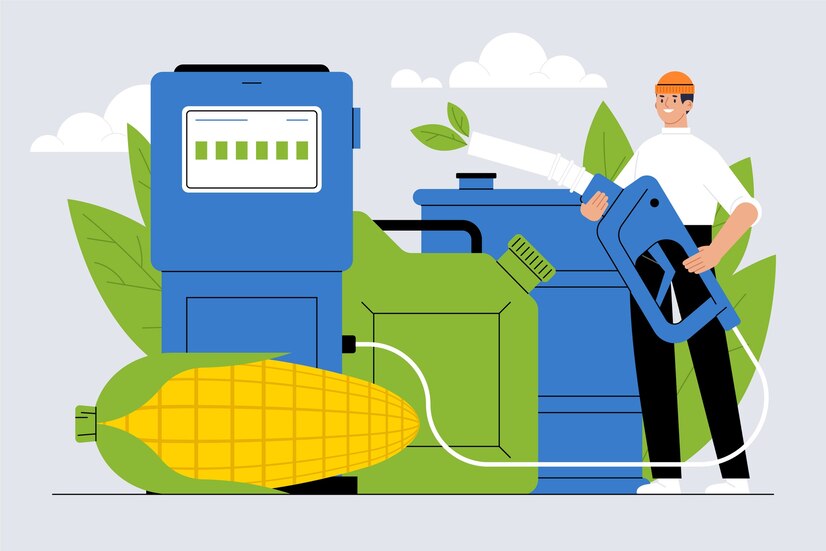Ethanol, a renewable biofuel derived from plants, has emerged as a popular fuel additive in many countries due to its environmental and economic benefits. While it has been widely used in the automotive and energy sectors, there are still ongoing discussions about its long-term viability and potential downsides. In this blog post, we’ll explore the advantages and considerations of using ethanol as a fuel additive, delving into its impact on the environment, vehicle performance, and the economy.
What is Ethanol?
Ethanol, commonly known as ethyl alcohol, is a clear, colorless liquid that is biodegradable and less toxic compared to conventional fossil fuels. It is primarily produced from plant materials, including corn, sugarcane, wheat, and other agricultural products. The process of creating ethanol involves fermenting the sugars in these crops, which are then distilled to produce fuel-grade ethanol.
When blended with gasoline, ethanol can act as a fuel additive that helps reduce greenhouse gas emissions, improve fuel efficiency, and promote the use of renewable energy. The most common blends of ethanol include E10 (10% ethanol and 90% gasoline) and E85 (85% ethanol and 15% gasoline), though other combinations are also available.
The Benefits of Ethanol as a Fuel Additive
- Reduces Greenhouse Gas Emissions
One of the most significant benefits of using ethanol as a fuel additive is its ability to reduce greenhouse gas emissions. Unlike gasoline, which is derived from fossil fuels, ethanol is considered carbon-neutral. This is because the carbon dioxide (CO2) absorbed by the crops during growth is roughly equal to the CO2 emitted when ethanol is burned. By blending ethanol with gasoline, there is a net reduction in CO2 emissions, helping to mitigate the effects of climate change.
According to the U.S. Department of Energy, the use of ethanol in gasoline can reduce life cycle greenhouse gas emissions by as much as 40% to 50% when compared to conventional gasoline. For consumers, this means lower emissions from their vehicles, contributing to cleaner air and a reduction in the carbon footprint of transportation.
- Renewable and Sustainable Resource
Ethanol is derived from renewable resources such as corn, sugarcane, and other crops, making it a sustainable alternative to non-renewable fossil fuels like gasoline. As the demand for energy continues to rise globally, the need for renewable energy sources becomes more critical. Ethanol provides an opportunity to reduce our reliance on finite resources, helping to ensure a more sustainable future.
Moreover, advancements in the production of cellulosic ethanol, which is derived from non-food-based feedstocks like agricultural waste and woody plants, offer further potential for sustainability. This development helps to reduce competition between food production and fuel, while also making ethanol production more environmentally friendly.
- Boosts Energy Independence
By using ethanol as a fuel additive, countries can reduce their dependence on imported oil. This is especially important for nations that rely heavily on foreign energy supplies, as it can improve energy security and reduce vulnerability to global oil price fluctuations. Countries like the United States and Brazil have invested heavily in ethanol production as part of their efforts to increase energy independence.
Ethanol production also creates economic opportunities for local farmers and rural communities. In regions where agricultural production is a significant part of the economy, the ethanol industry helps to provide jobs and boost income for farmers who grow the crops used to produce the fuel. As a result, ethanol can contribute to both national and local economic growth.
- Improves Octane Rating
Ethanol is an oxygenate, meaning it contains oxygen molecules that help gasoline burn more completely and efficiently. When blended with gasoline, ethanol increases the octane rating of the fuel, which is a measure of how resistant the fuel is to knocking (or pre-ignition) in the engine. Higher-octane fuels can improve engine performance and efficiency, leading to better acceleration and reduced engine knocking.
For modern vehicles, this can translate into smoother operation and potentially lower maintenance costs over time. Ethanol-blended fuels, such as E10, are widely available and provide consumers with a higher-quality fuel option that can enhance vehicle performance without requiring significant changes to the engine.
Considerations When Using Ethanol as a Fuel Additive
- Lower Energy Content
One of the main drawbacks of ethanol as a fuel additive is its lower energy content compared to gasoline. Ethanol contains about 33% less energy per gallon than gasoline, which can result in a slight decrease in fuel efficiency. Vehicles running on ethanol-blended fuels may experience lower miles per gallon (MPG) compared to pure gasoline, although the difference is generally small when using blends like E10.
For higher ethanol blends like E85, the impact on fuel efficiency is more pronounced, and vehicles designed to run on E85 may experience a significant reduction in MPG. However, advancements in engine technology and the design of flexible-fuel vehicles (FFVs) help mitigate this issue by optimizing performance for ethanol-based fuels.
- Corrosive Properties
Ethanol has been known to have corrosive effects on certain materials commonly used in older vehicle engines, including rubber and aluminum. While most modern vehicles are designed to accommodate ethanol-blended fuels, older cars may require modifications or the use of fuel additives to prevent damage to engine components. Ethanol’s hygroscopic nature, meaning it absorbs water from the air, can also lead to water contamination in the fuel system if the fuel is stored for extended periods.
This makes ethanol-blended fuels less suitable for boats, lawn equipment, and older vehicles that are not frequently used or properly maintained. To address these concerns, some vehicle owners opt for ethanol-free gasoline for specialized or vintage vehicles.
- Competition with Food Production
Another consideration when using ethanol as a fuel additive is the potential competition between fuel and food production. Since a significant portion of ethanol is derived from food crops like corn, there are concerns that increased demand for biofuels could drive up food prices or reduce the availability of certain crops for human consumption.
However, with the development of cellulosic ethanol, which uses non-food-based feedstocks, the industry is working to reduce the competition between food and fuel. These advancements hold promise for a more balanced and sustainable approach to ethanol production.
- Regional Availability
The availability of ethanol-blended fuels can vary depending on the region. In countries like the United States and Brazil, where ethanol production is well-established, consumers have easy access to ethanol-blended fuels at most gas stations. However, in other regions, the infrastructure for ethanol production and distribution may not be as developed, limiting the availability of these fuels.
For consumers in areas where ethanol-blended fuels are not readily available, the benefits of using ethanol as a fuel additive may be less accessible. Governments and energy producers will need to invest in infrastructure improvements to expand the adoption of ethanol in these regions.
Conclusion
Ethanol as a fuel additive offers a range of benefits, from reducing greenhouse gas emissions and promoting energy independence to improving fuel performance and providing economic opportunities for farmers. However, there are also important considerations to keep in mind, such as its lower energy content, corrosive properties, and the potential impact on food production.
As technology continues to advance, the ethanol industry is working to address these challenges, making it an increasingly viable and sustainable option for the future of transportation. By weighing the benefits and considerations, consumers and policymakers can make informed decisions about the role ethanol should play in the global energy landscape.


